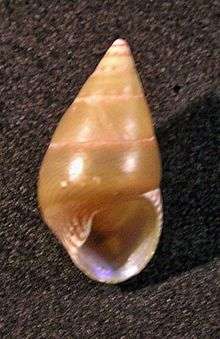Phasianotrochus apicinus
Phasianotrochus apicinus, common name the pointed kelp shell, is a species of sea snail, a marine gastropod mollusk in the family Trochidae, the top snails.[1]
| Phasianotrochus apicinus | |
|---|---|
 | |
| Apertural view of a shell of Phasianotrochus apicinus | |
| Scientific classification | |
| Kingdom: | Animalia |
| Phylum: | Mollusca |
| Class: | Gastropoda |
| Clade: | Vetigastropoda |
| Order: | Trochida |
| Superfamily: | Trochoidea |
| Family: | Trochidae |
| Genus: | Phasianotrochus |
| Species: | P. apicinus |
| Binomial name | |
| Phasianotrochus apicinus (Menke, 1843) | |
| Synonyms | |
| |
Description
The height of the shell attains 20 mm. The imperforate, solid, smooth shell has an elongated conical shape. It is shining, grayish, or brownish-yellow, with numerous narrow, fine, crowded, obliquely longitudinal red lines. These are often hard to perceive on account of the golden and violet iridescence. The whole surface is microscopically spirally striate. The striae are coarser on the base. The 8 to 9 whorls are nearly flat. The upper whorls are pink. The acute spire is turreted, and straight sided. The sutures are linear, sometimes with a white margin. The body whorl is rounded at the periphery. The oval aperture is slightly exceeding one-third the total length of the shell. It is smooth and not sulcate. It is beautifully iridescent within. The columella has a subacute tooth below the middle.[2]
Distribution
This marine species is endemic to Australia and occurs in the shallow subtidal zones off Victoria, Southern Australia, Western Australia and the north coast of Tasmania
References
- Marshall, B. (2013). Phasianotrochus apicinus (Menke, 1843). Accessed through: World Register of Marine Species at http://www.marinespecies.org/aphia.php?p=taxdetails&id=719244 on 2014-02-13
- Tryon (1889), Manual of Conchology XI, Academy of Natural Sciences, Philadelphia
- Menke, C.T. 1843. Molluscorum Novae Hollandiae Specimen in Libraria Aulica Hahniana. Hannover : Hahniana 46 pp
- Philippi, R.A. 1850. Trochidae. pp. 121–136 in Küster, H.C. (ed). Systematisches Conchylien-Cabinet von Martini und Chemnitz. Nürnberg : Bauer & Raspe Vol. II.
- Angas, G.F. 1867. A list of species of marine Mollusca found in Port Jackson harbour, New South Wales and on the adjacent coasts, with notes on their habits etc. Proceedings of the Zoological Society of London 1867: 185-233, 912-935
- Tenison-Woods, J.E. 1876. Description of new Tasmanian shells. Papers and Proceedings of the Royal Society of Tasmania 1875: 134-162
- Allan, J.K. 1950. Australian Shells: with related animals living in the sea, in freshwater and on the land. Melbourne : Georgian House xix, 470 pp., 45 pls, 112 text figs.
- Cotton, B.C. 1959. South Australian Mollusca. Archaeogastropoda. Handbook of the Flora and Fauna of South Australia. Adelaide : South Australian Government Printer 449 pp
- Ludbrook, N.H. 1978. Quaternary molluscs of the western part of the Eucla Basin. Bulletin of the Geological Survey of Western Australia 125: 1-286 92, pl. 20, figs 5, 11
- Wilson, B. 1993. Australian Marine Shells. Prosobranch Gastropods. Kallaroo, Western Australia : Odyssey Publishing Vol. 1
External links
- To World Register of Marine Species
- "Phasianotrochus apicinus". Gastropods.com. Retrieved 16 January 2019.
| Wikimedia Commons has media related to Phasianotrochus apicinus. |